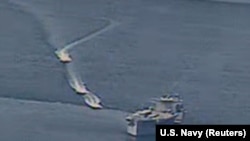The U.S. military has warned Iran that armed vessels approaching within 100 meters of U.S. Navy ships in the Persian Gulf region risk being "interpreted as a threat and subject to lawful defensive measures."
The maritime broadcast warning issued on May 19 comes after U.S. President Donald Trump warned last month that the U.S. Navy would “shoot down and destroy any and all Iranian gunboats harassing our ships at sea.”
The U.S Navy broadcast issued to mariners said the warning was given “due to recent events, in order to enhance safety, minimize ambiguity, and reduce opportunities for miscalculation.”
In April, the U.S. Navy’s Bahrain-based 5th Fleet accused Iran's Islamic Revolutionary Guards Corps (IRGC) of making "dangerous and harassing approaches" toward U.S. warships in the Persian Gulf.
For years, small Iranian vessels and speedboats have approached or harassed U.S. warships plying the Persian Gulf and Strait of Hormuz, where tankers pass carrying 20 percent of the world’s traded oil.
But the latest tensions come as the United States and Iran have been brought to the brink of conflict several times in the past year as Washington’s policy of “maximum pressure” has been met by Tehran’s “maximum resistance” after Trump withdrew from Tehran’s nuclear deal with world powers in 2018.
Iran last year seized ships in the Persian Gulf and Gulf of Oman, and the United States accused Tehran of attacking several tankers in the region.
The United States blamed Iran for being behind an attack on a Saudi Aramco oil facility, while Iran shot down a U.S. drone it claimed was over its territory.
In Iraq, tit-for-tat escalation between U.S. forces and Iran-backed Iraqi militias led to a U.S. drone strike in January killing IRGC commander Qasem Soleimani and a top Iraqi militia commander in Baghdad. In response, Iran launched ballistic missiles on an Iraqi base housing U.S. troops that caused traumatic brain injury to more than 100 U.S. soldiers.
Iranian officials have also repeatedly issued threats against U.S. warships in the region.
In the Persian Gulf, the danger of naval miscalculation is heightened by a lack of direct communication and an absence of a so-called deconfliction line between the U.S. and Iranian militaries. Instead, U.S. Navy ships rely on bridge-to-bridge contact with Iranian gunboats.
“These tactical, ad hoc communications between Iranian and U.S. vessels leave officers of limited authority in charge of preventing unintended confrontations and containing them if and when they occur,” the International Crisis Group said in a report in April.
“The adversaries’ incapacity to communicate instantly when incidents happen opens the door to unintentional escalation if one side misreads the situation and, as a result, miscalculates,” the conflict prevention organization said.





